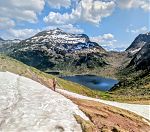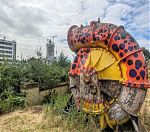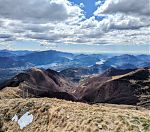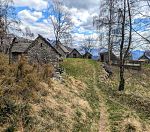1. August 2023
Swiss Peaks 360, Support Period Reviewed
 What I called the support period in my preparation for this year’s edition of the Swiss Peaks 360 foot race is complete. Time to look back, assess progress, shape the last training period before the big adventure, which will bring me to the vast mountaineous landscape of Valais in Switzerland.
What I called the support period in my preparation for this year’s edition of the Swiss Peaks 360 foot race is complete. Time to look back, assess progress, shape the last training period before the big adventure, which will bring me to the vast mountaineous landscape of Valais in Switzerland.
What I said would happen
What was the plan, originally? It’s easy to forget what I said over four months ago, like in February when I wrote Swiss Peaks 360, Prepping for the Next Edition. It’s easy to forget what I said over three months ago in April when I wrote Swiss Peaks 360, Base Period Reviewed. But since I wrote things down, I can now look at what my original plans were.
The support period/training is a term that I established for myself in order to structure the long training period. From the outset, in February, I set the following intention:
In the “support period”, I am working on ability to sustain higher intensities for longer periods of time (think: tempo runs, fartlek run).
In April, I planned to include some downhill technique training in the support period, as well as some track sessions:
In retrospect, my intention on doing hill sprints and downhill technique and track sessions were too ambitious [in the base period]. These ideas were competing for the same time slots in my calendar. The call for focusing on hill sprints was the right one, I need to introduce a few track sessions in the coming weeks, and make a new plan for addressing downhill technique in the next [support] period.
Additionally, I intended to use drills in order to improve running form in selected workouts:
At the end, I consider radical changes to running form risky (from experience, too), and intend to only occasionally sprinkle in some drills to occasionally bring some bounce into the legs prior to specific workouts.
What actually happened
Within the eleven weeks, I completed eleven runs with tempo intervals (mostly on my run-commute), three runs with VO2max intervals. I’m happy with this. I also continued to increase volume (modulating from week to week) with the biggest week in this period covering 81 km and 3.3 km of elevation gain. I remembered my intention to improve on downhill technique whenever I encountered downhill section presented itself. Long, technical downhill sections however aren’t close by.
Most of my training happend in my local neighborhood, having not yet build up to long days out in the mountains. However, in April, I sneaked in a couple of trips to Ticino regardless, and later in June another rather spectacular trip from Ennenda via Murgseen to Walensee. On both occasions, I had to reroute several times in order to avoid patches of snow.
The maintenance aspect, I feel, has come a bit short: sprinkling in the one or other VO2max interval or hill sprints in order to maintain whatever was achieved—I remember scheduling these workouts, but for some reason they did not happen […]. I completely forgot about the drills to bring some bounce (back) into the legs, too. Opportunities missed.
On the social side, I organised an event where we invited fellow trail-maniacs from other crews in Switzerland. This, I must say, and that’s thanks to the enthusiastic participants, was a smashing success: we explored local trails (though participants will remember the event for the cake, as it turns out), and rounded off the run with food and drinks and chatting. Another milestone on my integration into the local trail running community, and one that involved both taking and giving.
What’s next
As I am writing this, it’s already one month into the roughly two months of specific training. For the specific training, it’s time to do more of stuff that I can expect in the foot race: long days out in the mountains with long uphill sections and long downhill sections; fine-tuning gear and logistics; (re)familiarizing myself with the route.







